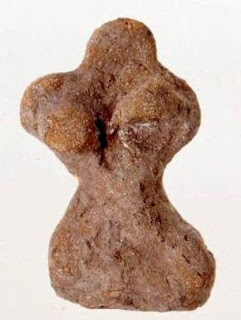< A Venus statue made from a
reindeer horn, in Nebra, Germany >
Last
time, we looked at the female statue and the Venus statue that were made from 35000
years ago to 15000 years ago.
We looked
at the first situation that human beings hold an image in their mind and manufactures it as a statue
that can be taken in hand.
This
time, we look at a diversification of the female statue and some statues except
a female type.
The
upper Venus statue is introduced last time. A Gonnersdorf ruins are located 300
km away from the ruins that this Venus statue was found in the same Germany.
Here, one
group was living in some tent on the flat ground along the Rhine only
wintertime at about 15000 years ago.
In this
ruins, the researcher unearthed many clay stone into which the woman image is carved
by drawing line. It just resembled the
touch of the Addaura Cave painting, "Birth of primitive art 2 ".
The
picture was the side view that abbreviated the head and a leg. and it expressed
the hand, the breast and the buttock by two outlines.
The
Venus statues discovered here was completely the same as the upper Venus statue.
前回、私達は35000~15000年前に作られたビーナス像を見ました。
そこには人類がイメージを膨らまし、手に取ることが出来る像として製作する最初の様子を見ました。
今回は、女性像の多様化と、女性像以外の像を見ます。
上記像は前回紹介したものです。このビーナス像の見つかった地から西300km離れた同じドイツにゲナスドルフ遺跡がある。
ここで15000年前頃、ライン河添いの平地に集団が冬期だけ数張りのテント生活をしていた。
この遺跡から、線刻で女性が描かれている粘板岩が多く発掘された。ちょうど「原初美術の誕生1」addaura洞窟壁画のタッチに似ている。
その絵は頭と脚は省略され、手と乳房と臀部のみが2本の輪郭線で表現された側面図であった。ここで発見されたビーナス像は上記像とまったく同じであった。
< The Venus image on the latter
half of Upper Paleolithic in Eurasian Continent (about 18000~13000 years ago)、by「縄文時代のはじまり」小林
謙一 >
These
are the Venus statues at last stage of the glacial epoch. These Venus statues
of side view type were distributed among about 2400 km from west France to the
east Ukraine.
Although
it is a simple form altogether, there is individuality, respectively. A diversity
of Aesthetic sense and symbolization has already arisen here. It is a culture.
The
clay figure of fig.7 (Siberia) in upper figure resembles the oldest clay figure
of Japan.
これらは氷河期末期のビーナス像です。これら側面観のビーナス像は、西のフランスから東のウクライナまでの約2400kmの間に分布していた。
すべてシンプルな形態ではあるが、それぞれ個性がある。ここには既に美的感覚、象徴化の文化に多様性が生じている。
図中の7マイニンスカヤ(シベリヤ)の土偶だけは、日本の縄文時代創生期の土偶(花輪台など)に似ている。
< Clay figure, Ibaraki Prefecture,
8000 years ago, 5 cm in height >
< Typical movable statues >
Much
movable statues expect the Venus statues were also made at the glacial epoch.
Those
many were the horses and bisons of hunting animals. Others were the mammoth,
the lion, the bird, and the goat.
In an
old thing, in a cave of southwest Germany, a horse statue was made from ivory
at 35000 years ago. Fig.1 (6 cm in length)
As a
unique thing, in a cave of south Germany, a lion man statue was made from ivory
at 32000 years ago. Fig.2 (30 cm in height) This
is the personified oldest thing and we associates it with the sphinx of Egypt.
The people soon will make a god statue that fulfills their dreams.
At
20000 years ago in France, an atlatl was made of a reindeer bone. Fig.3 (25 cm in length)
The
atlatl is a tool that doubled the driving distance of the spear.
Probably,
a simple expressive will and a desire of prayer arise first. The esthetic
pattern was established soon. Subsequently, it became a status symbol. I can
guess from the sketch of the clay stone discovered at the Gonnersdorf ruins.
From next time, we will look at the cave painting of
glacial epoch in Europe.
氷河期、動産美術はビーナス像以外にもたくさん作られた。それらの多くは狩猟動物である馬とバイソンが多く、他にはマンモス、ライオン、鳥、ヤギがあった。
古いものでは35000年前、南西ドイツの洞窟、象牙製馬、図1(長さ6cm)がある。また特異なものとしては32000年前、南ドイツの洞窟、象牙製ライオンマン図2(高さ30cm)が見つかった。これは擬人化された最古のもので、エジプトのスフィンクスを連想させる。もうすぐ人々が望む大きな力を持つ神像が誕生してくることになる。
20000年前、フランス、トナカイの骨製投槍器、図3(長さ25cm)がある。投槍器は、槍の飛距離を2倍にした道具です。
おそらく素朴な表現意欲と祈願の目的が先立ち、美的な文化様式が定着すると、やがてステイタスシンボルとなったのだろう。それがゲナスドルフ遺跡で発見された多くの粘板岩のデッサンから推察出来る。
次回から、氷河期ヨーロッパの洞窟絵画を見て行きます。





No comments:
Post a Comment
どうぞご意見をお書き下さい。Please write an opinion.